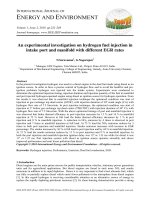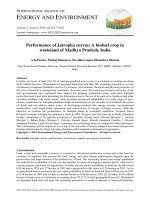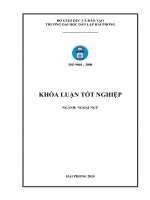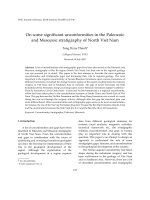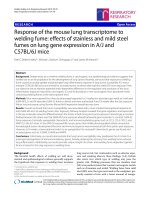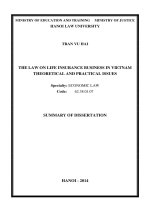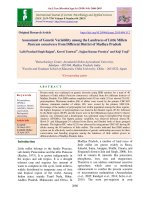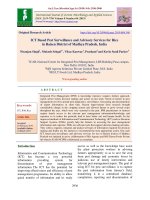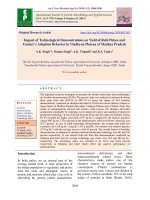Impact of technological interventions on productivity of mustard in Kymore plateau and Satpura hills zone of Madhya Pradesh
Bạn đang xem bản rút gọn của tài liệu. Xem và tải ngay bản đầy đủ của tài liệu tại đây (255.9 KB, 8 trang )
Int.J.Curr.Microbiol.App.Sci (2019) 8(2): 2848-2855
International Journal of Current Microbiology and Applied Sciences
ISSN: 2319-7706 Volume 8 Number 02 (2019)
Journal homepage:
Original Research Article
/>
Impact of Technological Interventions on Productivity of Mustard in
Kymore Plateau and Satpura Hills Zone of Madhya Pradesh
Jai Singh1, A.K. Singh2*, A.K. Chaubey1 and M.S. Baghel1
1
2
JNKVV Krishi Vigyan Kendra, Sidhi -486661, M.P., India
Krishi Vigyan Kendra, JNKVV, Jabalpur – 482004, M.P., India
*Corresponding author
ABSTRACT
Keywords
Indian mustard,
Technology
Frontline
demonstrations,
Extension gap,
Technology gap,
Technology index,
B:C ratio
Article Info
Accepted:
20 January 2019
Available Online:
10 February 2019
India is the fourth largest oilseed producer in the world. Among the edible oilseed crops
cultivated in India, mustard occupying the second position after groundnut sharing 27.5
per cent in Indian economy. It is also one of the important oilseed crops of Madhya
Pradesh and is commonly grown in Sidhi district which falls in Kymore Plateau and
Satpura Hills zone of the state. Krishi Vigyan Kendra, Sidhi conducted 64 technological
frontline demonstrations to know the yield gap between improved package of practices
(IP) and farmers practices (FP) under limited irrigation conditions. The study revealed that
the mustard yield in improved practice ranged from 8.75 to 13.23 q/ha whereas in farmers
practice it was in range of 6.70 to 10.09 q/ha. The technology demonstration on mustard
registered highest yield (13.23 q/ha) which recorded in 2014-15 in which was 31.11 per
cent higher over the farmer’s practice (10.09 q/ha). Extension gap and technology gap
ranged between 1.87 to 3.60 and 2.95 to 11.43 q/ha respectively. The technology index
ranged from 19.66 per cent to 57.15 per cent. The technology gap and index reflected
farmer’s collaboration in carrying out the technology demonstrations with encouraging
results in preceding years. The benefit cost ratio was estimated to be 2.15 to 3.64 under
demonstration, while it ranged from 1.91 to 2.85 under farmer’s practice. The results
indicated that these technology frontline demonstrations produced good impact on the
farming community of the district as they were motivated by the technological
interventions applied for considerably better production of mustard.
Introduction
Oilseed constitutes the second largest
agricultural commodity in India after cereals
accounting for nearly 5 per cent of gross
national product and 10 per cent of the value
of all agricultural products. Despite the fact
that India is one of the leading oilseed
producing countries in the world, it is not able
to meet the edible oil requirement for its own
vast population. Among the oilseeds, mustard
is an important oilseed crop of India standing
next to groundnut in terms of both area and
production. India is one of the largest
producer of rapeseed – mustard in the world
and contribute 19.29 per cent and 11.18
percent of total area and production
respectively (USDA, 2012) but the average
National productivity remains 1184 kg/ha
which is far below the world average 1950
2848
Int.J.Curr.Microbiol.App.Sci (2019) 8(2): 2848-2855
kg/ha. Its area of the country is 5.76 million
hectare with producing around 6.822 million
tonnes (Anonymous, 2016). In Madhya
Pradesh, rapeseed and mustard grown in an
area of 0.617 million hectare with total
production of 0.70 million tones and the
average productivity of 1134 kg/ha
(Anonymous, 2016). The area under mustard
is 6.8 thousand hectares in the Sidhi district of
Madhya
Pradesh.
However,
average
productivity of the district is 677 kg /ha which
is very low in comparison to that of the state
which is 1134 kg/ha. The low yield of
mustard in the Sidhi district are attributed to
the non availability of improved cultivars,
inadequate dose of fertilizers, non application
of secondary plant nutrients, untimely
management of diseases and pests etc. Among
the various agronomic practice������������������������������������������������������������������������������������������������������������������������������������������������������������������������������������������������������������������������������������������������������������������������������������������������������������������������������������������������������������������������������������������������������������������������������������������������������������������������������������������������������������������������������������������������������������������������������������������������������������������������������������������������������������������������������������������������������������������������������������������������������������������������������������������������������������������������������������������������������������������������������������������������������������������������������������������������������������������������������������������������������������������������������������������������������������������������������������������������������������������������������������������������������������������������������������������������������������������������������������������������������������������������������������������������������������������������������������������������������������������������������������������������������������������������������������������������������������������������������������������������������������������������������������������������������������������������������������������������������������������������������������������������������������������������������������������������������������������������������������������������������������������������������������������������������������������������������������������������������������������������������������������������������������������������������������������������������������������������������������������������������������������������������������������������������������������������������������������������������������������������������������������������������������������������������������������������������������������������������������������������������������������������������������������������������������������������������������������������������������������������������������������������������������������������������������������������������������������������������������������������������������������������������������������������������������������������������������������������������������������������������������������������������������������������������������������������������������������������������������������������������������������������������������������������������������������������������������������������������������������������������������������������������������������������������������������������������������������������������������������������������������������������������������������������������������������������������������������������������������������������������������������������������������������������������������������������������������������������������������������������������������������������������������������������������������������������������������������������������������������������������������������������������������������������������������������������������������������������������������������������������������������������������������������������������������������������������������������������������������������������������������������������������������������������������������������������������������������������������������������������������������������������������������������������������������������������������������������������������������������������������������������������������������������������������������������������������������������������������������������������������������������������������������������������������������������������������������������������������������������������������������������������������������������������������������������������������������������������������������������������������������������������������������������������������������������������������������������������������������������������������������������������������������������������������������������������������������������������������������������������������������������������������������������������������������������������������������������������������������������������������������������������������������������������������������������������������������������������������������������������������������������������������������������������������������������������������������������������������������������������������������������������������������������������������������������������������������������������������������������������������������������������������������������������������������������������������������������������������������������������������������������������������������������������������������������������������������������������������������������������������������������������������������������������������������������������������������������������������������������������������������������������������������������������������������������������������������������������������������������������������������������������������������������������������������������������������������������������������������������������������������������������������������������������������������������������������������������������������������������������������������������������������������������������������������������������������������������������������������������������������������������������������������������������������������������������������������������������������������������������������������������������������������������������������������������������������������������������������������������������������������������������������������������������������������������������������������������������������������������������������������������������������������������������������������������������������������������������������������������������������������������������������������������������������������������������������������������������������������������������������������������������������������������������������������������������������������������������������������������������������������������������������������������������������������������������������������������������������������������������������������������������������������������������������������������������������������������������������������������������������������������������������������������������������������������������������������������������������������������������������������������������������������������������������������������������������������������������������������������������������������������������������������������������������������������������������������������������������������������������������������������������������������������������������������������������������������������������������������������������������������������������������������������������������������������������������������������������������������������������������������������������������������������������������������������������������������������������������������������������������������������������������������������������������������������������������������������������������������������������������������������������������������������������������������������������������������������������������������������������������������������������������������������������������������������������������������������������������������������������������������������������������������������������������������������������������������������������������������������������������������������������������������������������������������������������������������������������������������������������������������������������������������������������������������������������������������������������������������������������������������������������������������������������������������������������������������������������������������������������������������������������������������������������������������������������������������������������������������������������������������������������������������������������������������������������������������������������������������������������������������������������������������������������������������������������������������������������������������������������������������������������������������������������������������������������������������������������������������������������������������������������������������������������������������������������������������������������������������������������������������������������������������������������������������������������������������������������������������������������������������������������������������������������������������������������������������������������������������������������������������������������������������������������������������������������������������������������������������������������������������������������������������������������������������������������������������������������������������������������������������������������������������������������������������������������������������������������������������������������������������������������������������������������������������������������������������������������������������������������������������������������������������������������������������������������������������������������������������������������������������������������������������������������������������������������������������������������������������������������������������������������������������������������������������������������������������������������������������������������������������������������������������������������������������������������������������������������������������������������������������������������������������������������������������������������������������������������������������������������������������������������������������������������������������������������������������������������������������������������������������������������������������������������������������������������������������������������������������������������������������������������������������������������������������������������������������������������������������������������������������������������������������������������������������������������������������������������������������������������������������������������������������������������������������������������������������������������������������������������������������������������������������������������������������������������������������������������������������������������������������������������������������������������������������������������������������������������������������������������������������������������������������������������������������������������������������������������������������������������������������������������������������������������������������������������������������������������������������������������������������������������������������������������������������������������������������������������������������������������������������������������������������������������������������������������������������������������������������������������������������������������������������������������������������������������������������������������������������������������������������������������������������������������������������������������������������������������������������������������������������������������������������������������������������������������������������������������������������������������������������������������������������������������������������������������������������������������������������������������������������������������������������������������������������������������������������������������������������������������������������������������������������������������������������������������������������������������������������������������������������������������������������������������������������������������������������������������������������������������������������������������������������������������46:0:0 kg/ha
Spray of Dimethoate @ 1
ml/litre
Sowing Methods
Farming
Situation
NPKS
Insect pest
management
Metalaxyl @ 6 g/ kg seed + PSB @ 5
g/kg seed
nd
Farmers Practice
Degenerated seeds of varuna
cultivar
4-5 kg/ha
Mixed with wheat/ gram/lentil
Nil
nd
2852
rd
Int.J.Curr.Microbiol.App.Sci (2019) 8(2): 2848-2855
Table.2 Effect of improved production technology on yield of mustard under frontline
demonstrations
Year
Variety
2009-10 JM-3
2010-11 Pusa Tarak
2011-12 Pusa Agrani
2012-13 Pusa Tarak
2013-14 Pusa Agrani
2014-15 Pusa Tarak
Total/ Average
No. of
demo.
Area
(ha)
Demo yield (kg/ ha)
Highest Lowest Average
05
12
11
12
12
12
64
2.0
5.0
4.8
5.0
5.0
5.0
26.8
972
953
1091
1310
1488
1523
1222.83
819
807
897
907
1176
1207
968.83
910
857
924
1195
1205
1323
1069
Yield of
per cent
Local Check increase over
(kg/ ha)
local check
695
31.5
670
31.20
725
27.44
835
43.11
987
28.19
1009
31.11
820.16
32.09
Table.3 Effect of improved production technology on aphid infestation and yield attributing
character of mustard
Year
Aphid infestation
(%)
%
decrease
in aphid
Improved Farmers infestation
Practice Practice over
farmers
practice
36.75
74.82
2009-10 8.5
76.23
91.14
2010-11 6.75
11.0
63.57
82.69
2011-12
9.5
56.3
83.12
2012-13
8.25
51.5
83.98
2013-14
7.0
59.5
88.23
2014-15
Average
8.5
57.33
83.99
Incidence of
Alternaria blight
(%)
Improved Farmers
Practice Practice
9.6
8.9
10.75
11.25
10.5
11.5
10.41
34.2
36.12
31.5
39.6
38.12
39.5
36.50
% decrease in
incidence of
Alterneria blight
over farmers
practice
71.90
75.35
65.87
71.59
72.45
70.88
71.34
Yield attributing
Characters (No. of
Siliquae / Plant)
Improved Farmers
Practice
Practice
149
159
159
179
156.2
158.33
160.08
112
117
128
121
112.0
114.7
117.45
% age
Increase
over
farmers
practice
33.03
35.89
24.21
47.93
39.46
38.03
36.42
Table.4 Economic impact of improved production technology of mustard under front line
demonstrations
Year
2009-10
2010-11
2011-12
2012-13
2013-14
2014-15
Average
Cost of Cultivation(Rs./
ha)
Improved Farmers
Practices Practices
7922.0
6692
8005.0
6775
7487.5
6315.0
8389.0
7016.0
12770.0
11300
12589.1
11077.2
9527.10
8195.86
Economics of Mustard Production (Rs./ha)
Net returns (Rs./ ha)
B:C ratio
Additional
Cost (q/ha.)
Improved Farmers Improved Farmers
Practices Practices Practices Practices
13840.0
6506.0
2.52
1.91
1250.0
8695.0
6065.0
2.15
1.96
1230.0
11292.5
8185.0
2.57
2.29
1272.5
21686.5
15559.0
3.64
2.85
1373.0
16355.0
11800
2.18
2.00
1470.0
23589.3
17202.7
2.78
2.55
1520.9
15909.71
10886.0
2.64
2.26
1352.73
2853
Additional Additional
return (Rs./ Benefit costha)
ratio
7334.0
2630.0
3107.5
6127.5
4555.0
6387.3
5023.58
5.86
2.13
2.44
4.46
3.08
4.20
3.71
Int.J.Curr.Microbiol.App.Sci (2019) 8(2): 2848-2855
Table.5 Technology gap, extension gap and technology index in mustard frontline
demonstrations
Year
Potential
Yield
(kg/ha)
2009-10
2010-11
2011-12
2012-13
2013-14
2014-15
Average
1600
1750
1600
1750
1600
1750
1675
Yield (kg/ ha)
Improved Practices Farmers Practices
910
857
924
1195
1205
1323
1069.0
Technology
gap
(kg/ha)
Extension
gap
(kg/ ha)
Technology
Index (%)
690.0
893.0
676.0
555.0
395.0
427
606.0
215
187
199
360
218
314
248.83
43.12
51.05
42.25
31.71
24.68
24.40
36.20
695
670
725
835
987
1009
820.16
The Improved production technology of
varieties (JM-3/Pusa Tarak/Pusa Agrani) of
mustard performed better (average yield 1069
kg ha-1) over the control i.e. farmers’ practice
(average yield 820.16 kg ha-1) at all the
locations under technology demonstrations.
From the above findings, conclusion can be
drawn that use of improved technology with
suitable variety can reduce the yield gap up to
a considerable extent leading to increased
productivity of mustard crop in the district.
Moreover, extension agencies in the district
need to provide proper technical guidance and
support to the farmers through different
educational and extension methods to reduce
the extension gap for better mustard
production in the district. KVK has also
played a major role in serving as a linkage
mechanism.
Acknowledgement
The authors are highly thankful to ICAR for
providing financial assistance towards
organizing frontline demonstrations of proven
technologies; yield potential of mustard thus
can be increased to a great extent. This will
subsequently increase the income as well as
the livelihood for the farming community.
References
Ahamad, A., Prem, G. and Kumar, R. (2013).
Impact of front line demonstrations on
Indian mustard through improved
technologies. Indian Res. J. Ext. Edu.,
13(1)117-119.
Anonymous (2016). Agricultural Statistics at
a Glance. Directorate of Economics
and
Statistics,
Department
of
Agriculture and Cooperation, New
Delhi.
Chanchal S and Lal M.N. (2009). Bioefficacy of plant extracts against
mustard aphid, Lipaphis erysimi
(Kalt.) In: Brassica oilseed crop. Crop
Res. 37: 203-206.
Dutta, R. (2014). Yield gap analysis of
Rapeseed – Mustard in North Bank
Plain Zone of Assam. Indian Res. J.
Ext. Edu.,14(3):122-124.
Jeengar, K.L., Panwar, P. and Parrek, O.P.
(2006). Front line demonstration on
maize in Bhilwara district of Rajsthan.
Current Agriculture, 30 (1/2):115-116.
Katare, Subhash; Pandey S.K. and Mustafa,
Mohd (2011). Yield gap analysis of
Rapeseed- mustard through front line
demonstrations. Agric. Update, 6: 5-7.
Meena, B.L., Meena, R.H. and Balai, C.M.
2854
Int.J.Curr.Microbiol.App.Sci (2019) 8(2): 2848-2855
(2012). Yield gap analysis of rapeseed
– mustard through front line
demonstrations in agroclimatic zone
IVa of Rajasthan. Journal of Oilseed
Brassica, 3(1): 51-55.
Ram, Siya and Anand, R.K. (2014). Yield gap
analysis of mustard through front line
demonstration in district Sonbhadra,
U.P. Int. J. Plant Sci., 9 (1): 180-182.
Samui, S.K., Maitra, S., Roy, D.K., Mandal,
A.K. and Saha, D. (2000). Evaluation
on front line demonstration on
groundnut. J. Indian Soc. Cos. Agri.
Res., 18(2): 180-183.
Sarma, H., Sarma, R., Sarmah, A.K.,
Upamanya, G.K. and Kalita, N.
(2014). Yield gap analysis of Toria
(Brassica compestris) in Barpeta
District of Assam. Indian Res. J. Ext.
Edu., 14(2):127-129.
Singh, C.P. and Lal, M. N. (2009). Bioefficacy of plant extract against
mustard aphid, Lipaphis erysimi
(Kalt.) In: Brassica oilseed crop. Crop
Research, 37: 203-206.
USDA. United States Department of
Agriculture (2012). Rapeseed-Mustard
Nutrient Values and yields. 2012, 114130.
Venkattakumar, R., Ramana, Rao, S.V.,
Padmaiah, M. and Madhuri, P. (2010).
Production
constraints
and
information needs of growers in
Andhra Pradesh. Agric. Extn. Review,
(April-June): 21-24.
How to cite this article:
Jai Singh, A.K. Singh, A.K. Chaubey and Baghel, M.S. 2019. Impact of Technological
Interventions on Productivity of Mustard in Kymore Plateau and Satpura Hills Zone of Madhya
Pradesh. Int.J.Curr.Microbiol.App.Sci. 8(02): 2848-2855.
doi: />
2855
